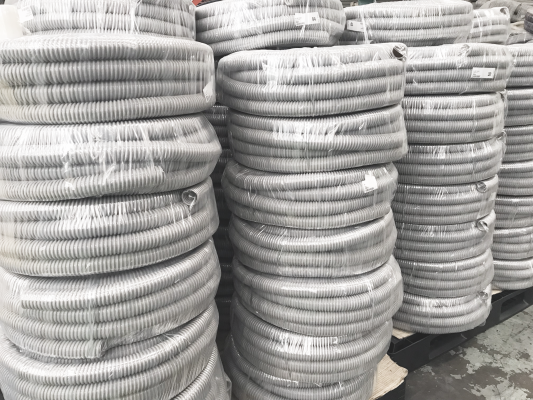Uncategorized
ข้อควรปฏิบัติ และการเก็บรักษาท่ออ่อนเพื่อยืดอายุการใช้งาน | Recommended Practices and Care & maintenance
โดยปกติแล้ว ท่ออ่อน PVC และสายยางทุกชนิดที่ใช้ในงานอุตสาหกรรม ส่วนประกอบเครื่องจักร ส่วนประกอบภายในสุขภัณฑ์ งานการเกษตร ฯลฯ ล้วนแล้วแต่มีอายุการใช้งานที่จำกัดด้วยกันทั้งสิ้น แต่ทั้งนี้ อายุการใช้งานจะยาวหรือสั้นนั้น ขึ้นอยู่กับหลายปัจจัย เช่นการเก็บรักษา และการใช้งาน เป็นต้น
ในบทความนี้ แอ็ดมินจะขอพูดถึงข้อควรปฏิบัติในการใช้งาน และการเก็บรักษาสายยางและท่ออ่อน PVC เพื่อการใช้งานที่ปลอดภัย ยาวนาน และได้ประสิทธิภาพสูงสุด

การใช้งานท่ออ่อนPVC และสายยางในงานอุตสาหกรรม ผู้ใช้งานควรมีคู่มือที่ระบุชัดเจนถึงการใช้งานของท่อและสายยางนั้นๆ และคู่มือขั้นตอนในการตรวจเช็คและสังเกตหาสิ่งผิดปกติของท่อ ซึ่งอายุการใช้งานของท่อขึ้นอยู่กับหลายปัจจัย เช่น วัตถุที่ถูกลำเลียงภายในท่อ แรงดัน แรงดูด การโค้ดงอ การเสียดสีภายนอก อุณหภูมิแวดล้อม เป็นต้น
สิ่งผิดปกติที่ผู้ใช้งานควรสังเกตมีดังต่อไปนี้
- รอยขาด รอยรั่ว รอยร้าว
- รอยพับ รอยย่น หรือรูบิดเบี้ยวจากสภาพปกติ
- ผิวชั้นนอก/ใน ลอกหรือร่อนออก
- ข้อต่อเริ่มหลวม หรือขยับออกจากจุดเดิม
ท่ออ่อนและสายยางมีหลากหลายชนิด และแต่ชนิดถูกออกแบบมาเพื่อใช้งานที่แตกต่างกันไป ผู้ใช้งานควรศึกษาข้อบ่งชี้ในการใช้งานท่อแต่ละชนิดให้ดี และเลือกใช้งานท่อหรือสายยางให้เหมาะสมกับงานมากที่สุด
- ท่อบางชนิดสามารถทนสารเคมีได้ ในขณะที่บางชนิดห้ามใช้กับสารเคมี
- ท่อแต่ละชนิดมีข้อจำกัดด้านแรงดันแรงดูดที่ไม่เหมือนกัน
- ท่อจะสามารถเกิดความเสียหายได้ง่ายขึ้นในอุณหภูมิสูง ดังนั้น ท่อจึงไม่ควรถูกจัดเก็บในที่ที่อุณหภูมิสูงเกินไปหรือใกล้แหล่งทำความร้อน
- ถึงแม้ว่าท่อและสายยางบางประเภทจะถูกออกแบบมาให้ใช้งานที่หนักได้ แต่ก็ไม่ควรโยน หรือปล่อยท่อให้หล่นจากที่สูง หรือเกิดแรงกระแทกอย่างแรงเพราะล้วนแต่จะสร้างความเสียหายและทำให้ลดอายุการใช้งานของท่อได้
- ไม่ควรดึงท่อหรือสายยางในการเคลื่อนย้ายเครื่องจักร
- ไม่ควรให้ท่อกระแทกกับของมีคมที่จะก่อให้เกิดรอยบาดได้
- หากใช้งานเสร็จแล้ว ควรเคลียวัตถุภายในท่อออกให้หมดแล้วจัดเก็บให้เรียบร้อย
วิธีการจัดเก็บท่อและสายยาง

วิธีการจัดเก็บท่อและสายยางที่แอ็ดมินกำลังจะพูดถึงต่อไป จะช่วยยืดอายุการใช้งานของท่อได้ หรืออย่างน้อยก็จะทำให้ท่อและสายยางสามารถคงสภาพที่ดีจนกว่าจะถึงอายุของมันได้
- ควรเก็บท่อและสายยางในที่ร่ม พ้นจากแสงแดด หรือ ควรเก็บห่างจากหลอดไฟ Fluorescent อย่างน้อย 10 ฟุต
- ควรเก็บท่อและสายยางบนพื้นเรียบ และไม่ควรเก็บสายยางเป็นแนวตั้ง เพราะจะทำให้ด้านที่อยู่ติดกับพื้นถูกทับจนสายแบนหรือเปลี่ยนรูปร่าง
- ไม่ควรวางท่อซ้อนกันเกิน 6 ม้วน เพราะท่อด้านล่างสุดที่โดนทับอาจจะแบนและเปลี่ยนรูปร่างได้ อย่างไรก็ตาม จำนวนท่อที่วางซ้อนกันจะขึ้นอยู่กับขนาดของท่อด้วย ตารางด้านล่างนี้แสดงจำนวนที่เหมาะสมที่สุดในการวางท่อซ้อนทับกัน อย่างไรก็ตาม ตัวเลขนี้เป็นเพียงคำแนะนำเบื้องต้น ทั้งนี้ จำนวนและการบิดของท่อขึ้นอยู่กับความหนาและความแข็งแรงของท่อแต่ละชนิดด้วย

- ก่อนเก็บท่อและสายยาง ควรห่อด้วยพลาสติกหรือฟิล์มยืดให้เรียบร้อยเพื่อป้องกันสิ่งสกปรก ฝุ่น และแมลง
- ไม่ควรเก็บท่อและสายยางในพื้นที่ที่มีน้ำ น้ำมัน สารตัวทำละลาย สารที่มีฤทธิ์กัดกร่อน และควัน
หากผู้ใช้งานทุกท่านปฏิบัติตามคำแนะนำและข้อห้ามที่แอ็ดมินได้ให้ไว้บนนี้ครบทั้งหมด แอ็ดมินเชื่อว่าท่ออ่อน PVC และสายยาง จะมีอายุการใช้งานที่ยาวนานขึ้นอย่างแน่นอน
—————————————————- English Version Below —————————————————-
Hoses have a limited service life and users must be alert to signs of impending failure. Users of industrial hose should have safety and inspection procedures in place. Hose users should be trained how to properly inspect a hose for signs of impending failure. Hose should be routinely inspected for signs of damage.
Length of hose service life is affected by several factors including the type of material conveyed, pressure, vacuum, number and degree of bends, amount of flexing and exposure to environmental elements.
Hoses and fittings should be routinely inspected for signs of damage, such as:
- Cuts, cracks, severe abrasions or holes in the hose tube, helical support or grounding wire
- Ovaling, kinking, bulging or any other deformation of the hose’s normal shape
- Hardening or soft spots
- Flaking or chipping
- Misalignment or weakening of the coupling retention
- Fitting or clamp damage such as loose clamps, missing pins, worn threads excessive corrosion
Hoses should only be used to convey materials compatible with hose construction, refer to the Chemical Resistance and Application Guidelines.
Hoses should not be used at levels that exceed their working pressure or vacuum ratings, and should not be subjected to severe pressure spikes or abrupt drops in pressure.
Hoses can sustain damage at high temperatures. Care should be exercised to not exceed the temperature limits of the hose. Hose should not be installed near sources of high heat.
Do not subject hose to abuse during service. Hose should not
be thrown, dropped or subjected to severe impacts. Machinery should not be moved by pulling on the hose. Protect the hose from sharp edges and corners by using appropriate hose covers or sleeves.
If hose is used in a suspended position it should be supported in multiple points with use of proper hose slings in order to evenly distribute the hose weight.
Hose should not be used in applications where hose failure would result in contents exposure to open flame or other ignition sources.
When not in service hoses should be drained and stored properly.

The following storage conditions and handling procedures can enhance and substantially extend the ultimate life of PVC hoses.
Hose should be stored indoors out of direct sunlight. Hose should be stored a minimum of ten feet from fluorescent light fixtures.
Hose should always be stored flat on smooth surfaces. Hose should not be stored on its side as this can cause the section of the hose resting on the ground to become deformed, or “egg shaped”.
Hose coils should not be stacked more than six coils high. Larger diameter hoses, 4” and above, should be stacked fewer than six coils high. Please refer to the following chart for recommended maximum stacking height requirements by hose size:

Exceeding these coil stacking requirements may cause the compression load factor on the bottom coil to exceed the hose’s load limitations, causing the bottom coil to flatten out.
Hose should be pulled from inventory on a first-in, first-out (FIFO) basis.
During storage, hose should be kept in its original wrapping when possible, and kept free of dust and dirt.
Hose should not be exposed to water, oils, solvents, or corrosive liquids and fumes during storage. Hose should be protected from rodents and insects.
Hose should not be kinked or run over by any equipment. Do not drag the hose during storage & shipping. In the handling of larger ID hose, dollies should be used in transporting whenever possible. Slings or handling rigs, properly placed in multiple locations throughout the hose, should be used to support heavier hose. Hanging and supporting coils using forklift forks without protection may damages hose.

